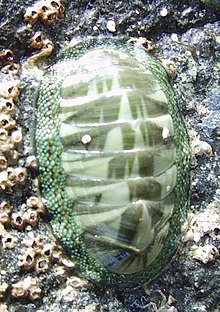Chiton glaucus
| Chiton glaucus | |
|---|---|
 |
|
| Scientific classification | |
| Kingdom: | Animalia |
| Phylum: | Mollusca |
| Class: | Polyplacophora |
| Order: | Chitonida |
| Suborder: | Chitonina |
| Superfamily: | Chitonoidea |
| Family: | Chitonidae |
| Genus: | Chiton |
| Species: | C. glaucus |
| Binomial name | |
|
Chiton glaucus (Gray, 1828) |
|
| Synonyms | |
|
Amaurochiton glaucus Iredale, 1914 |
|
Amaurochiton glaucus Iredale, 1914
Chiton glaucus, common name the green chiton or the Blue Green Chiton (Boyle, 1970) , is a species of chiton, a marine polyplacophoran mollusk in the family Chitonidae, the typical chitons. It is the most common chiton species in New Zealand.
The species Chiton glaucus are part of a very primitive group of Mollusc with evidence of being present in up to 80 million years of the fossil record. Taxonomists primarily use characteristics of the valves and the girdle to tell the difference between species and this is the case for Chiton glaucus (Creese, New Zealand Coastal Marine Invertebrates, 2010).
Chiton glaucus are oval in shape, with a slightly elevated yet definite ridge running down the back of the organism. This results in a bilateral symmetry.
The size of the organism is commonly 30-35mm long. The shell consists of eight overlapping valves. It is fairly large, up to 55 mm in length, with 6 intermediate valves between 2 terminal valves at either end of the organism.
These valves are surrounded by a girdle, which helps with adhesion to the preferred surface and in the case of Chiton glaucus it is covered in large scales.
The valves and girdle are generally uniform in a green colour, but individuals brown, buff and even light blue have been known to be found, especially in the North of New Zealand. This is sometimes combined with individuals who lighter chevron or zig zag markings. Underneath the body of the Chiton, there is a large foot which spans its total length. This is used to keep suction onto the chosen substrate. Gills are not obvious, instead being found in a set on either side of the foot. It has a small mouth at one end of the foot, however the mouth is merely a simple cavity.
This species is found throughout New Zealand. It is also present in Tasmania, becoming very common in estuaries (Powell, 1937). It is thought to have been introduced by shipping activity between Australia and New Zealand.
Chiton glaucus is found on the North, South and Stewart Islands, including the Chatham Islands.
...
Wikipedia
